The NVIDIA SHIELD Tablet Review
by Joshua Ho on July 29, 2014 9:00 AM ESTBattery Life
As always, battery life is one of the most important aspects of any mobile device, and is crucial to staying mobile. There’s not much introduction needed to this, as it’s rather well understood that more battery life is usually better. The Shield tablet features an integrated 19.75Wh battery.
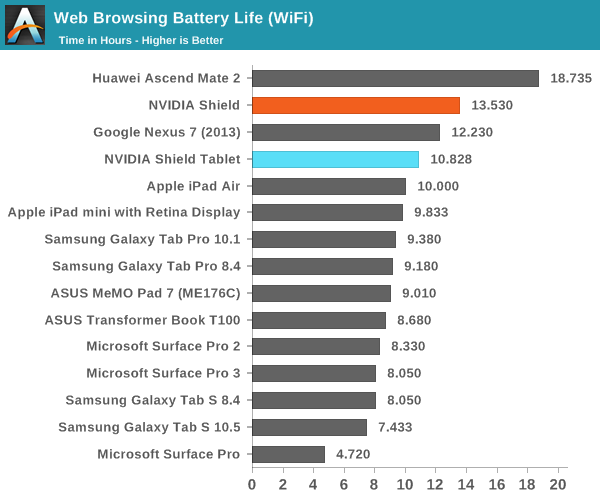
This device is a tablet first and foremost, so WiFi browsing battery life is important. In this area, the tablet does well. However, it’s a bit strange how the device performs worse than the Nexus 7 (2013). The reason why I say this is that the Tegra K1 is on a far more power efficient process (28HPm), has broadly equivalent battery capacity to screen area scaling, and should have a more power efficient display due to the reduced gamut. However, it could be that Cortex A15 just isn’t as power efficient as Krait and the silicon backplane of the display isn’t as efficient as the one in the Nexus 7.
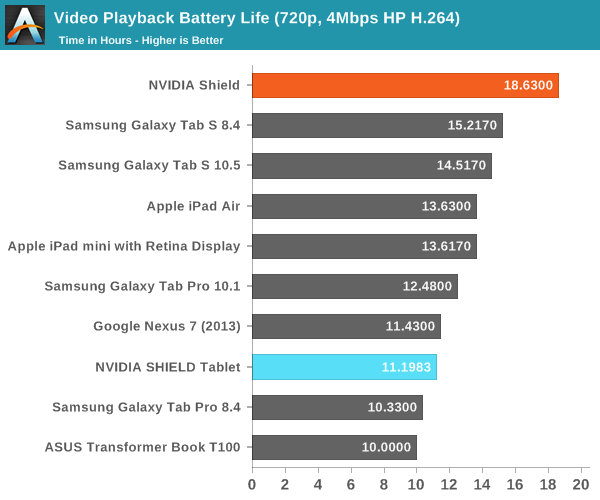
While normally web browsing tests are enough to cover the relatively low-compute use cases for smartphones, video playback is a significant use case for tablets. Here, we see that the gap between the Nexus 7 (2013) and the SHIELD Tablet narrows significantly, which can probably be attributed to the mostly display-bound nature of this test. Due to the much lower APL average of this test, we see that the Galaxy Tab S line does noticeably better in this test because their AMOLED displays mean that black-heavy content dramatically reduces power draw. This is because a black pixel in an AMOLED display is turned off and doesn't consume power, while an LCD display relies on a backlight so it isn't possible to turn off the backlight for a single pixel without turning off the entire display.

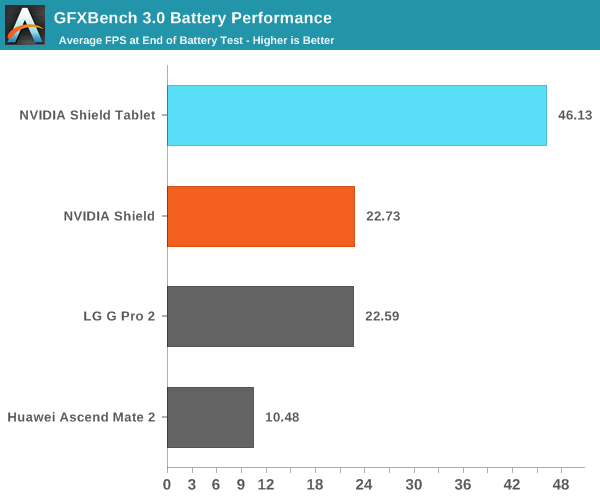
Of course, the Shield Tablet is also designed for gaming. Unfortunately, the Tegra K1 introduces quite a massive amount of dynamic range. While it’s fully possible for the Shield tablet to last 10 hours of continuous use on a single charge, running the GPU at full blast gives battery life similar to a gaming laptop. Realistically, if a game is made for Tegra K1 and truly stretches the GPU to the limit, battery life is only around two and a half hours, assuming display brightness is kept down to 200 nits. Of course, anything less intensive will do much better.
NVIDIA has also made it possible to cap the maximum frame rate and clock speed for better battery life. However, it’s quite clear in this test that the tablet isn’t capable of sustaining peak performance the way the Shield portable was, as the Shield portable sustained around 90% of the first run performance while the tablet sustained around 80% of its first run performance. The Shield Tablet also has noticeably higher skin temperatures, although this was a subjective observation.


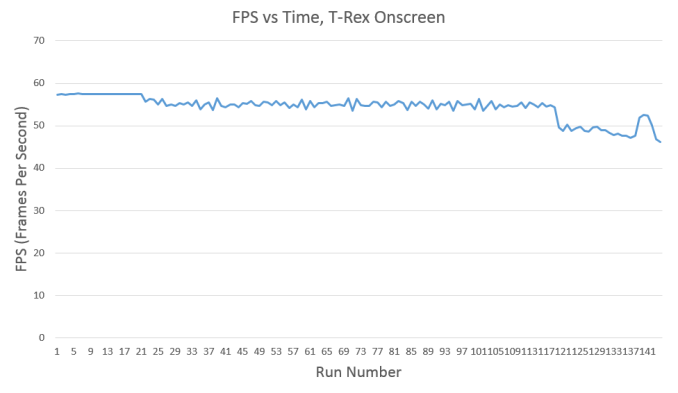
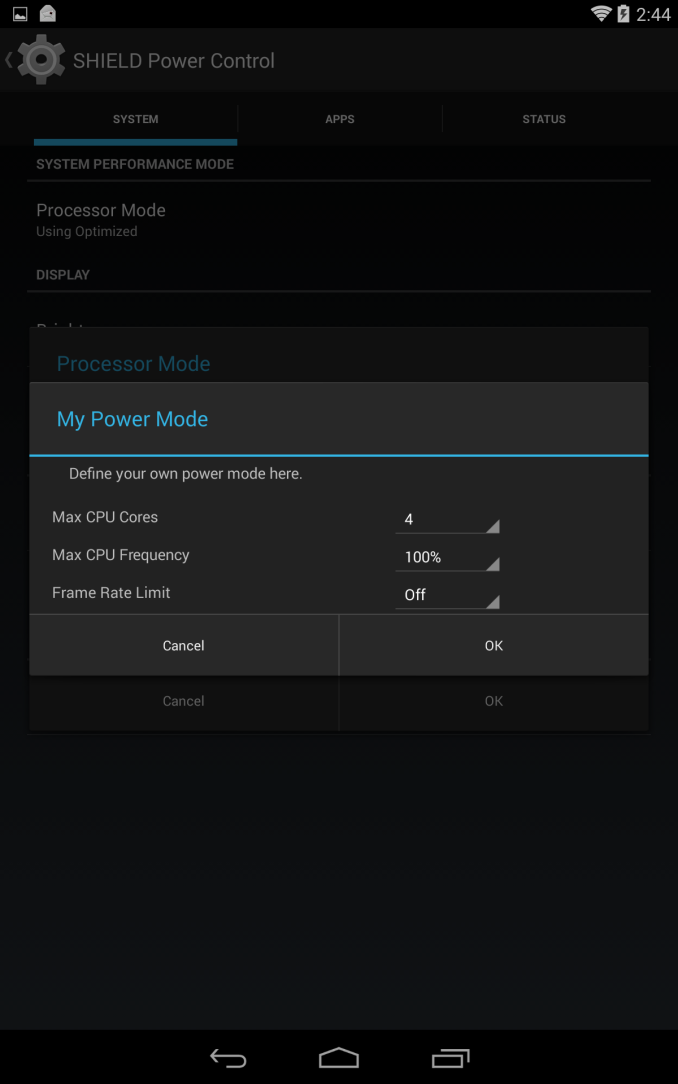
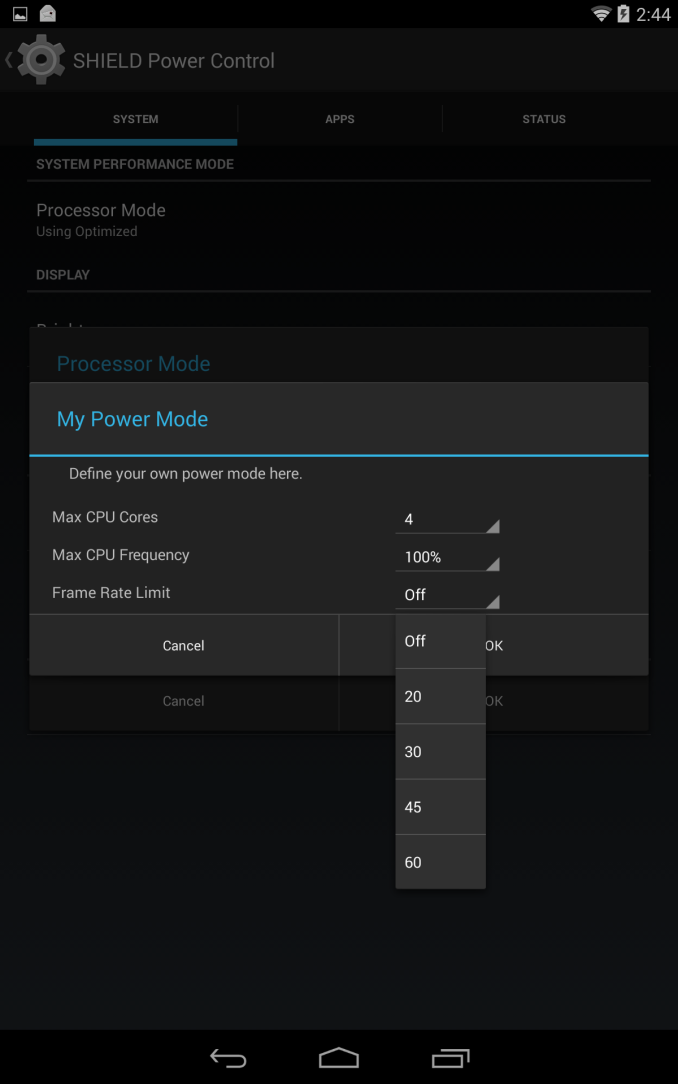








174 Comments
View All Comments
sherlockwing - Tuesday, July 29, 2014 - link
If and only if you are color blind.Moizy - Tuesday, July 29, 2014 - link
Crappy? It's no iPad Air or Nexus 7, but it's still good. Read Josh's article from the other day where he went back to the archives and tested smartphone panels that were once awesome in their day. Just 3 years ago we were praising the contrast of SAMOLED and the great resolutions those phones had. The Shield Tablet is leaps and bounds ahead of them, in accuracy, gamut, and pixel density, and just a tier below the iPad Airs and Nexus 7s of the world. For $300 and all this tablet can do, I would highly recommend this tablet to most anyone, and still plan on getting one for work and graduate school.boozed - Tuesday, July 29, 2014 - link
After reading "crappy" I was expecting a much worse result than the reality expressed in the review, so that's an exaggeration.I wouldn't be surprised if this screen still outperforms the majority of desktop gaming monitors out of the box.
edlee - Tuesday, July 29, 2014 - link
this soc it a powerhouse, nvidia is stupid that they do not mass produce it for mass produced products from HTC and Samsung. They made tablet GPU that is faster than Intel HD4000, which is pretty significant.But Nvidia doesn't have enough brand cognition for the simple consumer to know this is a killer product, not sure why you dont hear more partners for this soc.
melgross - Tuesday, July 29, 2014 - link
They do, but few manufacturers seem to want their SoC's.johnny_boy - Tuesday, July 29, 2014 - link
I don't get why since they make a pretty damn compelling SoC. Sure, previous generations weren't very exciting, but those were previous generations!phoenix_rizzen - Tuesday, July 29, 2014 - link
Fool me once (Tegra1), shame on me.Fool me twice (Tegra2), shame on you.
Fool me thrice (Tegra3), screw you!
Fool me a fourth time (Tegra4), I'll never listen to you again.
After all the hypocrisy and broken promises and what not from nVidia from the previous generations, is it really any wonder that no one wants to trust them again? All the big phone/tablet manufacturers are going to sit out this round and let nVidia go it alone. Maybe some smaller vendors will nibble at the line, and maybe some of them will have some successes with Tegra K1. But you won't see any major vendors using Tegra K1 until it proves itself in the market.
If nVidia hadn't burned so many bridges with Tegras 1-3 they'd be in a better position to take on Qualcomm, Samsung, ARM, and Intel. But, even with how good this SoC may be, it's still too little, too late.
Don't screw over your customers if you want them to be repeat customers!
TheJian - Wednesday, July 30, 2014 - link
You're mistaken. It was the only thing at google IO. In their automotive, their developer device (tango), TV, and it seems nexus tablet coming for gamers (9in IIRC).Too little too late? ROFL. It dominated the 805 and everything else here. Right on time is more like it. It will be in Google's Nov HTC Nexus 9 tablet at least. Mipad from xaiomi, Lenovo Thinkvision AIO 28, of course Jetson dev board also. I'm guessing A shield R2 coming shortly too with 1440x810 as the other specs that floated around showed (which clearly isn't this tablet, and it supposedly has 4GB ram, so again not this device). Small volumes right now probably prevent a dual launch of both shield products or they may wait for Denver since there is already quite a bit of interested parties using it as noted. If all you can produce goes to the above mentioned devices shield 2 may have to wait a bit.
akdj - Sunday, August 3, 2014 - link
Unfortunately, when ya want the 'power'. The promise of the 'performance'. And probably most importantly in today's mass market, it's 'efficiency'. Sure, they're flat hauling ASS in these benchmarks @ full tilt but a couple hours off the wall and you're done (with a AAA game that's the main draw to this tablet, right? --- I can't imagine the 'power' browser, or super reader or the 'AA' games I'm enjoying , Dark Room, The Room. Sometimes ya die. Maybe some car racing and if I've got the time an RPG FPS or an MMO, it's rare. In fact with my nine year old son it's 'his' time on my iDevices playing the games, the AA games that kick incredible ass but aren't AAA because they're not in a computer, console or dedicated gaming system. Laughable. I'm 43 and Ultima, Myst and Diablo A & B. Not the latest. Those were my games. Ultima online, I don't have the time nor do most 'tablet clients'. This is a niche product and an SoC with extreme limitations if you're taxing it's power. Obviously, using it as a movie watching, media browsing and light productivity....it's amazing efficiency. But, argument of color aside....we are moving to a HiDPI world with excellent color production on phones, tablets computers and TVs/4k, et al. If the screen is subjectively by the author after objective measurements confirming it.... 'Washed out' sounds lame. So does a pair of hours if I want to game a bit while on a three plus hour flight. A8 from Apple, Quallcomm NAND their 64bit architecture, significantly deeper libraries of apps, games and general interest software, Apple and Samsung, nor Google or ASUS, HTC LG or ABC going to take this risk again and it's exactly that. A speed demon you're unable to take advantage of if you're away for a charger. And a tablet plugged in = a major PITA. SoCs have to strike a balance. And with Metal/A8/Continuity and Google's response to come. Samsung's readying the new Note 4. Possible 805? With the 420, it'll fly through a helluva lot of games. And it's display is going to best the best today. The S5 from the same family. AMOLED has come a long way. IPS display with 'washed out' colors isn't appealing.akdj - Sunday, August 3, 2014 - link
No edit. Wasn't supposed to be Quallcom's NAND. Rather Qualcomm and their 64 bit response to second generation 64bit A8. Cool and exciting to have the completion but yeah, burned three times it was tough to trust a fourth gen to leave the shelf without the reliability of ARM, Snapdragon and the 'A' series Apple tweaked ARM SoCs. Both dedicated AND delivering with incredible improvements. Look at Note 1-->Note 3's benches. iPhone 4-->5s. Two years and mind bending speed, efficiency and even more software ('apps') then before with more possibilities. Intel now in w/BayTrail, I'm wishing nVidia the best. I'm a fan